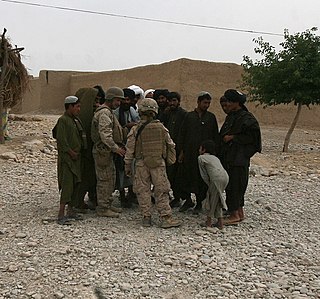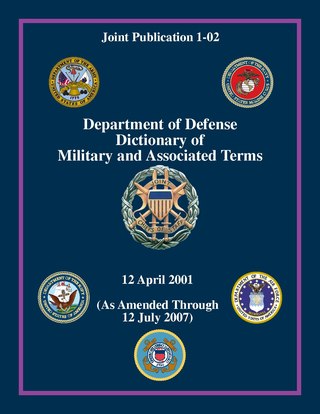Related Research Articles

Military intelligence is a military discipline that uses information collection and analysis approaches to provide guidance and direction to assist commanders in their decisions. This aim is achieved by providing an assessment of data from a range of sources, directed towards the commanders' mission requirements or responding to questions as part of operational or campaign planning. To provide an analysis, the commander's information requirements are first identified, which are then incorporated into intelligence collection, analysis, and dissemination.

Counterintelligence (counter-intelligence) or counterespionage (counter-espionage) is any activity aimed at protecting an agency's intelligence program from an opposition's intelligence service. It includes gathering information and conducting activities to prevent espionage, sabotage, assassinations or other intelligence activities conducted by, for, or on behalf of foreign powers, organizations or persons.
Intelligence assessment, or simply intel, is the development of behavior forecasts or recommended courses of action to the leadership of an organisation, based on wide ranges of available overt and covert information (intelligence). Assessments develop in response to leadership declaration requirements to inform decision-making. Assessment may be executed on behalf of a state, military or commercial organisation with ranges of information sources available to each.

The Bureau of Intelligence and Research (INR) is an intelligence agency in the United States Department of State. Its central mission is to provide all-source intelligence and analysis in support of U.S. diplomacy and foreign policy. INR is the oldest civilian element of the U.S. Intelligence Community and among the smallest, with roughly 300 personnel. Though lacking the resources and technology of other U.S. intelligence agencies, it is "one of the most highly regarded" for the quality of its work.
The intelligence cycle is an idealized model of how intelligence is processed in civilian and military intelligence agencies, and law enforcement organizations. It is a closed path consisting of repeating nodes, which will result in finished intelligence. The stages of the intelligence cycle include the issuance of requirements by decision makers, collection, processing, analysis, and publication of intelligence. The circuit is completed when decision makers provide feedback and revised requirements. The intelligence cycle is also called intelligence process by the U.S. Department of Defense (DoD) and the uniformed services.
Criminal intelligence is information compiled, analyzed, and/or disseminated in an effort to anticipate, prevent, or monitor criminal activity.
Title IX: Improved Intelligence is the ninth of ten titles which comprise the USA PATRIOT Act, an anti-terrorism bill passed in the United States after the September 11, 2001 attacks. It amends the National Security Act of 1947 to require the Director of Central Intelligence (DCI) to establish requirements and priorities for foreign intelligence collected under the Foreign Intelligence Surveillance Act of 1978 and to provide assistance to the United States Attorney General to ensure that information derived from electronic surveillance or physical searches is disseminated for efficient and effective foreign intelligence purposes.

The under secretary of defense for intelligence and security or USD(I&S) is a high-ranking civilian position in the Office of the Secretary of Defense (OSD) within the U.S. Department of Defense (DoD) that acts as the principal civilian advisor and deputy to the secretary of defense (SecDef) and deputy secretary of defense (DepSecDef) on matters relating to military intelligence and security. The under secretary is appointed as a civilian by the president and confirmed by the Senate to serve at the pleasure of the president.
Intelligence collection management is the process of managing and organizing the collection of intelligence from various sources. The collection department of an intelligence organization may attempt basic validation of what it collects, but is not supposed to analyze its significance. There is debate in U.S. intelligence community on the difference between validation and analysis, where the National Security Agency may try to interpret information when such interpretation is the job of another agency.
Intelligence cycle management refers to the overall activity of guiding the intelligence cycle, which is a set of processes used to provide decision-useful information (intelligence) to leaders. The cycle consists of several processes, including planning and direction, collection, processing and exploitation, analysis and production, and dissemination and integration. The related field of counterintelligence is tasked with impeding the intelligence efforts of others. Intelligence organizations are not infallible but, when properly managed and tasked, can be among the most valuable tools of management and government.
Intelligence dissemination management is a maxim of intelligence arguing that intelligence agencies advise policymakers instead of shaping policy. Due to the necessity of quick decision-making in periods of crisis, intelligence analysts may suggest possible actions, including a prediction of the consequences of each decision. Intelligence consumers and providers still struggle with the balance of what drives information flow. Dissemination is the part of the intelligence cycle that delivers products to consumers, and intelligence dissemination management refers to the process that encompasses organizing the dissemination of the finished intelligence.
National intelligence programs, and, by extension, the overall defenses of nations, are vulnerable to attack. It is the role of intelligence cycle security to protect the process embodied in the intelligence cycle, and that which it defends. A number of disciplines go into protecting the intelligence cycle. One of the challenges is there are a wide range of potential threats, so threat assessment, if complete, is a complex task. Governments try to protect three things:
Failure in the intelligence cycle or intelligence failure, is the outcome of the inadequacies within the intelligence cycle. The intelligence cycle itself consists of six steps that are constantly in motion: requirements, collection, processing and exploitation, analysis and production, dissemination and consumption, and feedback.
An intelligence collection plan (ICP) is the systematic process used by most modern armed forces and intelligence services to meet intelligence requirements through the tasking of all available resources to gather and provide pertinent information within a required time limit. Creating a collection plan is part of the intelligence cycle.

Document Exploitation (DOCEX) is the set of procedures used by the United States Armed Forces to discover, categorize, and use documents seized in combat operations. In the course of performing its missions in the War on Terrorism, members of the United States Armed Forces discover vast amounts of documents in many formats and languages. When documents are suspected of containing information of potential intelligence value, rapid and accurate interpretation of the information identifies targets, bolsters success in subsequent operations, and enhances tactical and strategic all-source intelligence efforts. The sheer volume of documents acquired in the course of military operations can overwhelm a unit's capability to extract meaningful information in a timely manner.
The Boren-McCurdy intelligence reform proposals were two legislative proposals from Senator David Boren and Representative Dave McCurdy in 1992. Both pieces of legislation proposed the creation of a National Intelligence Director. Neither bill passed into law.

Target analysis is an examination of potential targets to determine military importance, priority of attack, and weapons required to obtain a desired level of damage or casualties. The Central Intelligence Agency defines it as, "network analysis techniques and specialized analytical tools to identify and detail key figures and organizations who may pose a threat to US interests."
Agile Business Intelligence (BI) refers to the use of Agile software development for BI projects to reduce the time it takes for traditional BI to show value to the organization, and to help in quickly adapting to changing business needs. Agile BI enables the BI team and managers to make better business decisions, and to start doing this more quickly.

Counter-IED efforts are done primarily by military and law enforcement with the assistance of the diplomatic and financial communities. It involves a comprehensive approach of countering the threat networks that employ improvised explosive devices (IEDs), defeating the devices themselves, and training others. Counter-IED, or C-IED, is usually part of a broader counter-terrorism, counter-insurgency, or law enforcement effort. Because IEDs are a subset of a number of forms of asymmetric warfare used by insurgents and terrorists, C-IED activities are principally against adversaries and not only against IEDs. C-IED treats the IED as a systemic problem and aims to defeat the IED threat networks themselves.

Essential elements of information (EEI) is any critical intelligence information required by intelligence consumers to perform their mission. The EEI are specific to a particular event, thing, or other target individual. The EEI are written out in advance as questions by consumers of the EEI information. Then, the EEI questions are used by collectors of the information that may not be in direct contact with the consumer at the time the information is collected. A specific set of EEIs are used by collectors to develop a collection plan to find the answers to the questions in the EEIs. EEIs are also used in non-intelligence fields, such as responders to crisis events or medical emergencies.
References
- ↑ ReliaQuest (2021-06-17). "Let's Talk About Intel Requirements". ReliaQuest. Retrieved 2023-07-02.
- ↑ "The Seven-Step Intelligence Cycle" (PDF). Naval Postgraduate School .